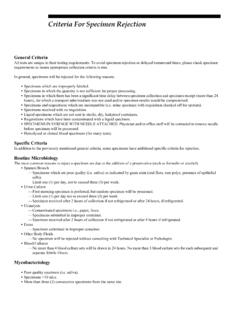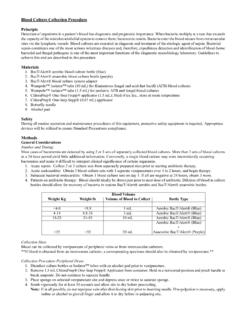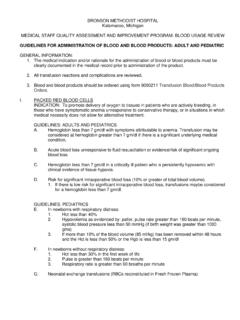Transcription of Specimen Collection, Preparation, and Transport
1 The accuracy of any result depends upon the quality of the Specimen . Following the collection , preparation, and Transport instructions help ensure the best possible test results. Proper identification of each Specimen is equally as important. Clearly label each Specimen with the patient s name and date collected. Submit a test request form complete with the patient s name, date of birth, sex, Social Security number, tests, and billing information including diagnosis. Any pertinent clinical information is also helpful to our technologists. blood collection Procedures and TransportWhen submitting blood specimens, please follow these guidelines: Fasting specimens are usually the specimens of choice, especially for chemistry procedures.
2 Hemolysis and lipemia frequently interfere with many reactions. Provide serum or plasma free from hemolysis and lipemia if at all possible. blood Film Preparation Put a small drop of fresh, whole blood from needle, finger-or heelstick onto a frosted slide. Draw a second slide toward the drop of blood at a 45 angle. (The slide may be held on a flat surface). Allow the blood to spread at the junction of the slides. Maintain a 45 angle to obtain a smooth, evenly distributed blood film. Push the spreader slide smoothly and quickly down the slide. If the drop of blood is too large, move the slide away from it before starting to make the film. A feathered edge indicates the best films.
3 Allow the film to air dry. Write the patient s name and date on the frosted end of the slide with a soft lead pencil. Place Specimen (s) in bag with request form and refrigerate unless test requirements specify different handling conditions. Plasma Grey-top (potassium oxalate/sodium fluoride) tube Lavender-top (EDTA) tube Tube submitted for blood Bank tests (including type and Rh, antibody screen, antibody identification) should not be spun down. Do not transfer plasma, leave tube intact. Send 1, full 10-mL tube or two, 4-mL tubes unopened. Light green-top (lithium heparin with gel) tube Light blue-top (sodium citrate) tube Royal blue-top (EDTA or sodium heparin) tube collection Procedure: Draw blood into a tube containing the appropriate anticoagulant.
4 If using a syringe, transfer the blood immediately to a tube containing anticoagulant. A citrate tube must be completely filled. Gently invert the tube 10 times to adequately mix the anticoagulant and blood . Centrifuge for 5 minutes. Taking care not to disturb the cells, transfer the plasma to a Transport tube with a disposable pipette and label the tube Plasma. Place Specimen (s) in bag with request form and refrigerate unless test requirements specify different handling conditions. Serum Note:Draw blood for tests requiring serum before drawing blood for tests requiring anticoagulants. Gold-top (SST , serum separator tube containing gel and clot activator) 5-mL tube: collection Procedure: Draw blood into an evacuated tube containing clot activating gel.
5 One full, 10-mL tube is recommended for every 4 mL of serum. Gently invert the serum separator tube 5 times to mix the clot activator and blood . Allow the blood to clot for 30 minutes. DO NOT REMOVE THE STOPPER. Centrifuge at full speed for 15 minutes. A barrier will form between the serum and the cells. Whether or not red cells are visible above the gel, if it does not form a complete barrier above the cells, either respin immediately for five more minutes or transfer the serum to plastic tube. Place Specimen (s) in bag with request form and refrigerate unless test requirements specify different handling conditions. Plain, red-top (no anticoagulant or separating gel) tube Royal blue-top (no additive) tubeSpecimen collection , Preparation, and Transport collection Procedure: Draw blood into an evacuated tube or syringe without anticoagulant or preservative.
6 One full, 10-mL tube is recommended to every 4 mL of serum needed. Allow the blood to clot, then centrifuge within 45 minutes of venipuncture for approximately 10 minutes. (Caution: prolonged centrifugation may cause hemolysis and evaporation.) Transfer the serum to clean Transport tube with a disposable pipette. Place Specimen (s) in bag with request form and refrigerate unless test requirements specify different handling conditions. Whole blood Green-top (lithium heparin) tube Green-top (sodium heparin) tube Grey-top (potassium oxalate/sodium fluoride) tube Lavender-top (EDTA) tube Light blue-top (sodium citrate) tube Light green-top (lithium heparin with gel) tube Royal blue-top (EDTA or sodium heparin) tube Yellow-top (ACD) tube collection Procedure: Draw blood into an evacuated tube containing the specified anticoagulant.
7 Promptly and gently invert the tube (do not shake). Repeat 10 times to mix the blood and anticoagulant. When using a syringe to draw the Specimen , immediately transfer the blood to the proper evacuated tube. To prevent hemolysis, puncture the rubber stopper with the syringe needle at an angle so the blood is drawn into the tube. Do not force the blood from the syringe into the tube. Overfilling may cause hemolysis, alter the blood /anticoagulant ration, or cause the stopper to become loose. Place Specimen (s) in bag with request form and refrigerate unless test requirements specify different handling Specimen collection ProceduresWhen submitting urine, serum, plasma, or whole blood for tests requiring frozen specimens, please follow these guidelines to assure Specimen integrity: Allow enough empty space in plastic container to accommodate expansion of the Specimen during freezing.
8 Specimens should not be frozen in glass containers. Use a waterproof pen or marker to label the Specimen with the patient s name and the date the Specimen was collected. Include total volume if the Specimen is a timed urine collection . If more than 1 test is ordered on a Specimen that requires freezing, please send a separate Specimen for each test ordered. Thawing a frozen Specimen to split it for different procedures damages Specimen integrity. Freeze Specimen immediately. Place Specimen (s) in bag with request form. SHIP Specimen FROZEN in dry ice. Specimen must remain frozen during of DrawWhen multiple blood specimens are drawn, special attention should be given to the order in which tubes are filled.
9 Specimens for blood cultures should be drawn first to prevent possible contamination from non-sterile stoppers. If blood is inoculated into tubes from a syringe, the same order should be followed. General Order of Draw First - blood culture tubes , sterile tubes Second - coagulation tubes (blue) Third - serum tubes (gold or red) Fourth - heparin tubes (green) Fifth - EDTA tubes (Lavender) Sixth - glycolytic inhibitor tubes (grey) Specimen collection tubes AvailableThe following is a list of tubes referred to in Specimen Required in the individual test listings: Gold-Top SST (Clot Activator and Gel for Separating Serum from Cells, but NO Anticoagulant) (5 mL) Tube: This tube is used for assays requiring serum.
10 Separate serum from cells within 45 minutes of venipuncture. Serum may be sent in tube with intact barrier. Green-Top (Lithium Heparin) (7 mL) Tube: Used for lithium heparin whole blood or plasma specimens. Send plasma in plastic transfer tube labeled Plasma-Heparin. Send whole blood in evacuated tube. Green-Top (Sodium Heparin) (10 mL) Tube: Used for heparinized whole blood or plasma specimens. Send plasma in plastic transfer tube labeled Plasma-Heparin. Send whole blood in evacuated tube. Grey-Top (Potassium Oxalate/Sodium Fluoride) (4 mL) Tube: Used for potassium oxalate/sodium fluoride whole blood or plasma. Send plasma in plastic transfer tube labeled Plasma-Fluoride.




